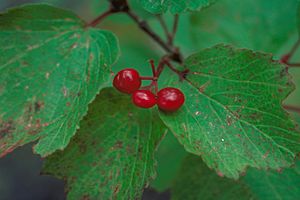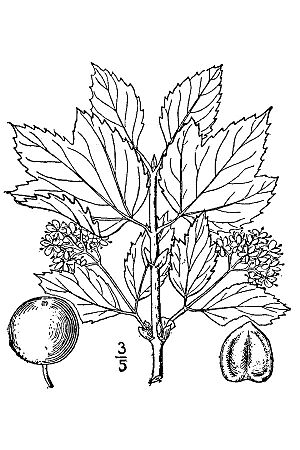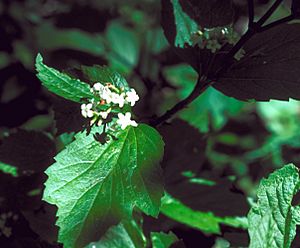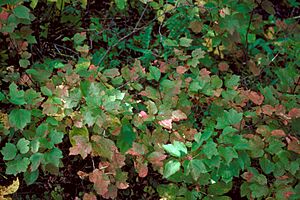Squashberry facts for kids
Quick facts for kids Squashberry |
|
|---|---|
 |
|
| Scientific classification | |
| Genus: |
Viburnum
|
| Species: |
edule
|
The squashberry (also known as mooseberry or pembina) is a type of shrub that grows in Canada and the northern parts of the United States. It usually stands about 2 meters (6.5 feet) tall and has many stems with smooth branches.
Its berries are tart and ripen early in spring. Many birds and mammals enjoy eating them. People can also eat the berries after removing the seeds, and they are often used to make tasty jam.
Contents
What Does Squashberry Look Like?
The squashberry is a deciduous shrub, which means its leaves fall off in autumn. It can grow from 0.5 to 3.5 meters (1.5 to 11.5 feet) tall.
Leaves and Bark
Its leaves grow opposite each other on the stem. They are oval-shaped, about 6–10 cm (2.4–3.9 inches) long, and can be unlobed or have three shallow lobes. The edges of the leaves are jagged, and they turn a beautiful red color in the fall. The underside of the leaves is smooth, especially along the veins. The bark of the plant is smooth and reddish-grey, and its twigs are also smooth.
Flowers and Fruit
The flowers of the squashberry grow in small, round clusters about 1–3 cm (0.4–1.2 inches) wide. The flowers are white and have five petals that are joined at the bottom, forming a tube.
The fruit is a red or orange berry-like fruit called a drupe. This means it has a fleshy outside and a single hard seed (or "stone") inside. The fruits are 0.8–1.5 cm (0.3–0.6 inches) long and grow in clusters.
How Did Squashberry Get Its Name?
The scientific name for squashberry is Viburnum edule. The word edule comes from a Latin word that means "edible," which makes sense because the berries can be eaten!
A French botanist named André Michaux was one of the first to give the plant a scientific name in 1803. Later, another naturalist, Constantine Samuel Rafinesque, also studied the plant. Because scientists didn't always communicate easily back then, the plant ended up with a few different names. Eventually, Viburnum edule became the official scientific name we use today.
Squashberry was once thought to be part of the honeysuckle family (Caprifoliaceae). However, after more modern scientific studies, it was reclassified into the moschatel family (Adoxaceae).
Where Does Squashberry Grow?
Squashberry plants like to grow in damp soil in different types of forests. You can also find them in areas with many trees and shrubs, near wetlands, and by bodies of water. They even grow at higher elevations on gravel banks. The best soil for squashberry is moist, well-drained soil, often found near rivers (called alluvial soil).
Seed Dispersal
Animals like birds and mammals help spread squashberry seeds. They eat the berries, and then the seeds pass through their bodies and are dropped in new places, helping new plants grow.
Distribution
Squashberry is found all across Canada, throughout Alaska, and in the northern states of the USA. It grows in places like the Yukon, northern Quebec, and from Newfoundland down to Oregon, Idaho, Colorado, Minnesota, and Pennsylvania. It often grows as a main plant in the understory (the plants growing beneath the main trees) of white spruce forests. Squashberry is also known as a pioneer species, meaning it's one of the first plants to grow back after forest fires.
How People and Animals Use Squashberry
The tart fruit of the squashberry is often eaten fresh. It's also great for making jams and jellies. Many wild animals eat these berries as part of their diet. Smaller animals can also use the plant's dense growth for shelter.
Traditional Uses
Different parts of the squashberry plant have been used in herbal medicine for a long time. For example, the berries have been used to make cough medicines. The roots have been used to make tea to help with tooth pain or a sore throat. Chewing the twigs or gargling with a tea made from them could also treat a sore throat. Some people even massaged the closed flower buds on their lips to treat lip sores. Modern studies have shown that the fruit is rich in antioxidants, which are good for your health.
Many Indigenous peoples have traditionally used the squashberry plant. The Nuxalk people from British Columbia, Canada, use the berries for food because the plant grows quickly and produces many berries. A single squashberry shrub can produce up to 100 berries! Some First Nations groups on the northwestern coast of North America even planted squashberry in their forest gardens. The berries are mentioned in some origin myths of the Haida, often as food eaten at feasts or by supernatural beings. Inuit people near the Nain settlement in Newfoundland and Labrador also traditionally collect these wild fruits.




